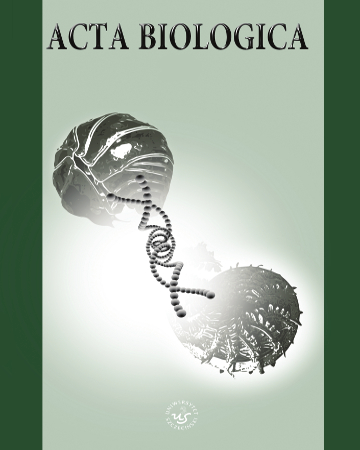
ISSN: 2450-8330
OAI
DOI: 10.18276/ab.2017.24-09



Issue archive /
No. 24
Body satisfaction versus anthropometric and lifestyle characteristics in secondary school youth in a three-year study
| Authors: |
Ewa
Rębacz-Maron
University of Szczecin, Department of Vertebrate Zoology and Anthropology, Institute for Research on Biodiversity, Faculty of Biology Patryk Lisiecki Student of biology at the University of Szczecin |
| Keywords: | body satisfaction anthropometry high-school youth lifestyle eating habits eating behaviours |
| Data publikacji całości: | 2017 |
| Page range: | 11 (89-99) |
Abstract
Background. The current trend for a slim body has spread to all age groups and social strata. It is
necessary to monitor health- and eating-related behaviours among young people to counteract
bad eating habits.
Aim. To examine body satisfaction taking into account anthropometrics and physical activity
data in high-school youth over the course of a three-year study.
Material & Methods. Anthropological examinations on the same high-school students were
conducted in: 2014, 2015, 2016 – always in September. The parameters measured included:
body weight, body height (B-v), waist and hip circumference. Somatic indices were calculated:
BMI, WHR, Rohrer’s index. The study also included a questionnaire with questions about the
number of hours of physical activity per week, the length of time in training in a given sports
discipline, self-assessment of body satisfaction and eating habits.
Results. For both girls and boys the intensity of physical exercise declined year by year.
The potential reason may be that the young people got to know one another after the first year
and did not feel compelled to work on their body (to appear more attractive). As many as 56%
of girls were not satisfied with their body in first grade and 71% of boys. In the two subsequent
years, dissatisfaction rates dropped for both sexes.
Conclusions. There is a need for health-promoting programmes so that young people can learn
about the principles of nutrition and not experiment with excessive dieting.
Download file
Article file
Bibliography
| 1. | Diedrichs, P.C., Lee, Ch. (2010). GI Joe Or Average Joe? The impact of average-size and muscular male fashion models on men’s and women’s body image and advertisement effectiveness. Body Image, 3 (7), 218–226. DOI: 10.1016/j.bodyim.2010.03.004. |
| 2. | Drozdowski, Z. (1998). Antropometria w wychowaniu fizycznym. Poznań: AWF. |
| 3. | Frederick, D.A., Buchanan, G.M., Sadehgi-Azar, L., Peplau, L.A., Haselton, M.G., Berezovskaya, A. Lipin¬ski, R.E. (2007). Desiring the muscular ideal: Men’s body satisfaction in the United States, Ukraine and Ghana. Psychology of Men & Masculinity, 8, 103–117. DOI: 10.1037/1524-9220.8.2.103. |
| 4. | Kakeshita, I.S., Almeida, S.S. (2006). Relationship betwen body mass index and self-perception among university students. Rev Saúde Pública, 3 (40). |
| 5. | Levitsky, D.A. (2005). The non-regulation of food intake in humans: hope for reversing the epidemic of obesity. Physiol Behav, 5 (86), 623–632. |
| 6. | Lipowska, M., Lipowski, M. (2006). Ocena własnej atrakcyjności przez kobiety w różnym wieku. In: A. Chybicka, M. Kaźmierczak (eds.), Kobieta w kulturze – kultura w kobiecie (pp. 385–402). Kraków: Oficyna Wydawnicza Impuls. |
| 7. | Lipowski, M., Lipowska, M. (2015). Poziom narcyzmu jako moderator relacji pomiędzy obiektywnymi wymiarami ciała a stosunkiem do własnej cielesności młodych mężczyzn. Polskie Forum Psychologiczne, 1 (20), 31–46. |
| 8. | Łaska-Mierzejewska, T. (1997). Ćwiczenia z antropologii. Warszawa: AWF. |
| 9. | McCreary, D.R., Saucier, D.M. (2009). Drive for muscularity, body comparison and social physique anxiety in men and women. Body Image, 1 (6),24–30. |
| 10. | McGuire, M.T. (1999). What predicts weight regain in a group of successful weight losers? J Consult Clin Psychol, 67, 177–185. |
| 11. | Myszkowska-Ryciak, J., Gago, E., Harton, A. (2015). Wiedza żywieniowa oraz postrzeganie własnej masy ciała przez nastoletnie dziewczęta. In: A. Wolska-Adamczyk (ed.), Znaczenie racjonalnego żywienia w edukacji zdrowotnej. Warszawa: WSIiZ. |
| 12. | Patton, G.C., Selzer, R., Coffey, C., Carlin, J.B., Wolfe, R. (1999). Onset of adolescent eating disorders: population based cohort study over 3 years. Br. Med. J., 318 (7186), 765–768. |
| 13. | Physical status: the Use and Interpretation of Anthropometry (1995). Report of a WHO expert committee. WHO Tech Rep Ser, 854, 1–452. |
| 14. | Romanowska-Tołłoczko, A., Kałwa, M. (2014). Oddziaływania psychologiczne w kompleksowej terapii nadwagi. Probl Hig Epidemiol, 2 (95), 209–214. |
| 15. | Sandler, R., Slemenda, C.W., LaPorte, R.E., et al. (1985). Postmenopausal bone density and milk consump¬tion in childhood and adolescence. Am J Clin Nutr, 42, 270–274. |
| 16. | Schneider, N., Frieler, K., Pfeiffer, E., Lehmkuhl, U., Salbach-Andrae, H. (2009). Comparison of body size estimation with different types of eating disorders. Eat Disord Rev, 17, 468–475. |
| 17. | Sorensen, T., Stunkard, A., Teasdale, T., Higgins, M. (1983). The accuracy of reports of weight: children’s recall of their parents weights 15 y earlier. Int J Obs, 7, 115–122. |
| 18. | Szponar, L., Respondek, W. (2000). Choroby pierwotne na tle niedoborów żywieniowych. Żywienie czło¬wieka zdrowego i chorego. Warszawa: Wydawnictwo Naukowe PWN. |
| 19. | Tanofsky-Kraff, M., Cohen, M.L., Yanovsky, S.Z., Cox, Ch., Heim, K.R., Keil, M., Reynolds, J.C., Yano-vski, A. (2006). A prospective study of psychological predictors of body fat gain among children at high risk for adult obesity. Pediatrics, 117, 1203–1209. |
| 20. | The Surgeon General’s Report on Nutrition and Health (1988). Washington, DC: US Public Health Service, Office of the Surgeon General. |
| 21. | Tylka, T.L. (2011). Refinement of the tripartite influence model for men: Dual body image pathways to body change behaviors. Body Image, 3 (8), 199–207. |
| 22. | Wojtyła-Buciora, P., Marcinkowski, J.T. (2010). Sposób żywienia, zadowolenie z własnego wyglądu i wyobrażenie o idealnej sylwetce młodzieży licealnej. Probl Hig Epidemiol, 2 (91), 227–232. |
| 23. | Woynarowska, B. (2003). Środowisko psychospołeczne szkoły i przystosowanie szkolne a zdrowie i zachowanie zdrowotne uczniów w Polsce. Raport z badań. Warszawa. |